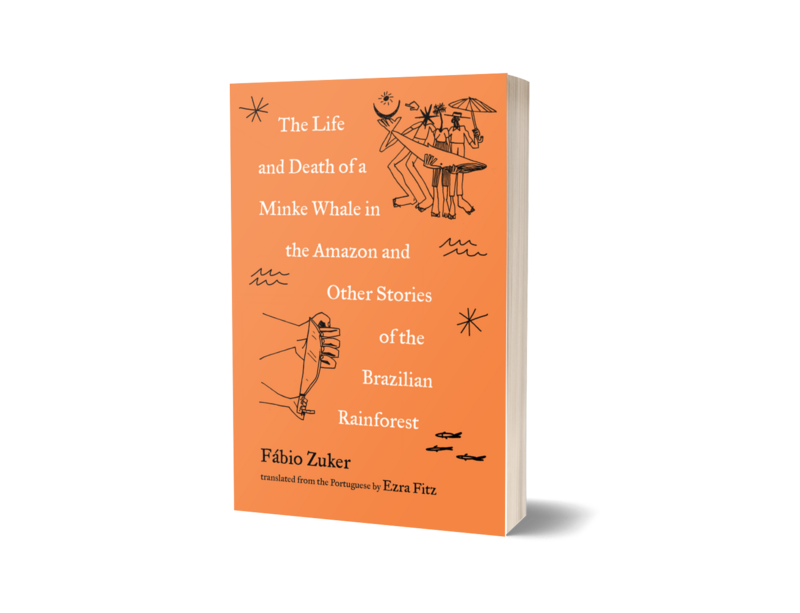A Whale in the Amazon Forest: a Cover Image Story

by: Fábio Zuker
ENGLISH
A whale in the amazon forest: a cover image story
“Space and time move in mutual dependence. It’s as if rivers, lakes, and forests can slow or even halt the passage of time as it’s traditionally conceived: an arrow shot across a smooth surface. It’s not like a car driving down the road. In the Amazon, time will take its time, at least as long as there are rivers and forests.”
I decided to quote an excerpt from my book, The Life and Death of a Minke Whale and Other Stories of the Brazilian Rainforest—which Milkweed is publishing in May 2022—to begin this essay. Maybe not the most usual approach, but I feel that phrase contextualizes a lot of my book. It is an attempt to write how violent recent transformations, of the Amazon forest are, here summarized in the contrast between two experiences of time and space that are irreducible to each other. The road as a straight line that can be traversed without many barriers synthesizes the form of spatiality that tries to impose itself on the multiple forms of life intertwined in the mesh of relationships that make up the forest.
In one of the essays in the book, the unusual appearance of a minke whale in the middle of the rainforest is the starting point for a reflection on the arrival of soybeans mono-crops and the destruction it causes. In another, the arrival of Venezuelan immigrants fleeing the Nicolás Maduro regime allows for a reflection on how they came to occupy the place usually assigned by local politicians to indigenous people as targets of false news and misinformation that fuel the dirty game of politicians in some Amazonian states. In another essay, a young Tukano indigenous woman is bitten by a jararaca snake. Her experience shows the decolonization of medicinal knowledge between indigenous people and the Brazilian State. While the doctors intended to amputate the girl’s leg to save her, the indigenous healers go to court in order to heal her with traditional medicine. To relieve any potential stress you might be feeling from reading this: she does not get her leg amputated and she is a young woman full of life.
Taken together, these reports and essays tell the story of what is happening today in the largest forest in the world. The Life and Death of a Minke Whale explores the destruction of indigenous territories and other traditional populations and what that means for these people who trace a way of existence of great intimacy and mutual constitution with the forest, rivers, and non-human beings.
The forms of destruction experienced in contemporary Amazonia impose on these people a painful change in the world tissue. But this is also a book about resistance, about the creation of other worlds, amid the destruction of this one. The narratives are permeated by the warrior urge to seek alternatives to the reality imposed by an extractive and neocolonial development model that press the Amazon, which seems to generate little benefit for those who actually live there.
In addition to the numbers and satellite images of fires, translating this book into English will give the American reader another angle from which to understand these violent processes that are taking place today in the Amazon. They are first-hand accounts of those who live up close to the huge fires that affect the region. Or traditional communities of small farmers who lived close to the forest, and that, little by little, witnessed the advance of soy plantations that exude pesticides and passed to surround them.
The cover of this book also reveals many things about the writing. The drawings were made by Gustavo Caboco, an indigenous artist from the Amazon who has lived in southern Brazil for many years. They are almost imaginative drawings, freely inspired by the book’s content but an art piece on its own. My Brazilian editor Laura Daviña, from Publication Studio São Paulo, suggested and commissioned Caboco’s illustrations.
In fact, it was through the Publication Studio network that Mary Austin Speaker found out about my book. She nominated the book for Milkweed Editions, and in a few months, she’d be working on its cover, combining Caboco’s drawings with the long title, while Ezra and I dove into the challenge of translating specifically Amazonian terms (their tones, smells, and sensations ) for an American audience.
The book also has some interludes, backstage trips, and investigations, in which I share personal situations with the reader. Moments of fear, like what I felt when I found alone, while paddling, a black jaguar crossing the river at a point in the forest. But also moments of laughter when getting rid of embarrassing situations with interviewees.
PORTUGUESE
Uma baleia na floresta amazônica: um texto sobre a imagem da capa
“Espaço e tempo transcorrem em mútua dependência. Como se rios, lagos e florestas impedissem o passar do tempo concebido à imagem de uma seta que transcorre sobre uma superfície lisa. O oposto da imagem de um carro sobre uma estrada. Na Amazônia, o tempo ainda é um tempo que tarda a passar. Pelo menos enquanto houver rios e florestas”.
Eu decidi citar um trecho do meu livro The Life and Death of a Minke Whale and Other Stories of the Brazilian Rainforest — que vai ser publicado pela editora Milkweed em Maio de 2022 — para dar início a este ensaio. Talvez não seja o mais usual, mas eu sinto que essa frase condensa muito do que é este livro. Uma tentativa de escrever as violentas e recentes transformações da Amazônia, aqui sintetizada na contraposição entre duas experiências de tempo e espaço irredutíveis uma à outra. A estrada como uma linha reta que pode ser percorrida sem muitos obstáculos sintetiza a forma de espacialidade que tenta se criar sobre as múltiplas formas de vida que se entrelaçam na malha de relações que compõem a floresta.
Em uma das histórias, o inusitado aparecimento de uma baleia-minke em plena floresta tropical é o ponto de partida para uma reflexão sobre a chegada da soja, e a destruição que ela causa. Em outra, a chegada de imigrantes venezuelanos fugindo do regime de Nicolás Maduro permite uma reflexão sobre como eles passaram a ocupar o lugar atribuído por políticos locais aos indígenas, como alvos de fake-news e desinformação que servem de combustível para o jogo sujo de políticos em alguns estados Amazônicos. Ainda em outra história, uma jovem indígena Tukano picada por uma jararaca enseja uma reflexão sobre a descolonização dos saberes medicinais entre indígenas e o Estado brasileiro — enquanto os médicos querem amputar a perna da garota para salvá-la, os indígenas entram na justiça para poder curá-la com medicina tradicional. Se você está se sentindo incomodado ao ler isso: ela não teve a perna amputada e é hoje uma jovem cheia de vida em sua comunidade.
Tomado como um todo, essas reportagens reportagens e ensaios contam a história do que está acontecendo hoje na maior floresta do mundo.
The Life and Death of a Minke Whale atenta para a a destruição de territórios indígenas e de outras populações tradicionais e o que isso significa para essas pessoas que traçam uma forma de existência de muita intimidade e constituição mútua junto à floresta, aos rios e com os seres não humanos.
As formas de destruição vivenciadas na Amazônia contemporânea impõem a essas pessoas uma dolorosa mudança na tessitura do mundo, que cabe aqui ser narrada. Mas este também é um livro sobre resistência, sobre feição de outros mundos, em meio à destruição deste. As narrativas são permeadas pelo ímpeto guerreiro de buscar alternativas à realidade criada por um modelo extrativista e neocolonial de desenvolvimento que se impõe sobre a Amazônia, mas que pouco parece gerar benefícios para quem de fato vive ali.
Para além dos números e imagens de satélites sobre queimadas, a tradução deste livro para o inglês permitirá ao leitor americano um outro ângulo a partir do qual entender esses violentos processos que ocorrem hoje na Amazônia. São relatos em primeira mão, sobre quem vive de perto as queimadas de enormes proporções que atingem a região. Ou sobre as comunidades tradicionais de pequenos agricultores que viviam junto à floresta, e ao poucos foram testemunhando o avanço de plantações de soja que transpiram agrotóxicos, e passaram a cercá-los.
A capa desse livro também revela muitas coisas sobre a escrita. Os desenhos foram feitos por Gustavo Caboco, um artista indígena da Amazônia, mas que vive há muitos anos no Sul do Brasil. Quem sugeriu e encomendou as ilustrações de Caboco foi a minha editora Laura Daviña, do Publication Studio São Paulo.
Aliás, foi pela rede do Publication Studio que a Mary Austin Speaker tomou conhecimento do meu livro. Ela indicou o livro para a Milkweed Editions, e em alguns meses, estaria já trabalhando na capa dele, combinando os desenhos de Caboco com o longo título, enquanto Ezra e eu mergulhávamos no desafio de traduzir termos especificamente amazônicos (suas tonalidades, cheiros e sensações) para um público americano.
O livro conta também com alguns interlúdios, bastidores das viagens e apurações, nos quais eu compartilho com o leitor situações pessoais. Momentos de medo, como o que senti ao encontrar sozinho, enquanto remava, uma onça preta cruzando o rio em um ponto da floresta. Mas também momentos de riso, ao me livrar de situações embaraçosas junto a entrevistados.


